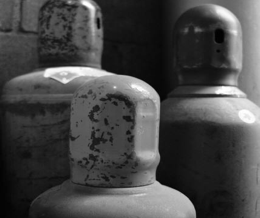If your workplace contains compressed gas, there are several hazards to consider to avoid a potentially dangerous workplace accident.
Make sure you read all supplied documentation before handling. Labels on the cylinder and the Material Safety Data Sheet (MSDS) supplied with the gas will contain information on its hazardous properties, such as toxic, flammable, or oxidizer.
In addition to the hazards of the specific gases themselves, compressed gas cylinders pose additional hazards simply because they contain gas under pressure. Regardless of the properties of the gas, any gas under pressure can explode if the cylinder is improperly stored or handled. Improperly releasing the gas from a compressed gas cylinder is extremely dangerous. A balloon flies around the room when its gas is suddenly released; however, unlike harmless balloons, cylinders have been known to penetrate concrete-block walls. A sudden release of the gas can cause a cylinder to become a missile-like projectile, destroying everything in its path.
To prevent such a dangerous situation, there are several general procedures to follow for safe storage and handling of a compressed gas cylinder:
- Store cylinders in an area specifically designated for that purpose. This area must protect the cylinders from being struck by another object. The area must be well ventilated and away from sources of heat, and at least 20 feet away from highly combustible materials. Oxidizers must be stored at least 20 feet away from flammable gases.
- Cylinders must not be dropped or allowed to fall. Chain and rack them in an upright position during use and storage. When transporting cylinders, they must be secured to keep from falling.
- When moving a cylinder, even for a short distance, all the valves must be closed, the regulator removed, and the valve cap installed. Never use the valve cap to lift a cylinder. If you are using a crane or some other lifting device to move a cylinder, use a cradle or boat designed for that purpose. Never use a sling or a magnet to move a cylinder.
- Never permit cylinders to contact live electrical equipment or grounding cables.
- Cylinders must be protected from the sun's direct rays, especially in high-temperature climates. Cylinders must also be protected from ice and snow accumulation.
- Before the gas is used, install the proper pressure-reducing regulator on the valve. After installation, verify the regulator is working, that all gauges are operating correctly, and that all connections are tight to ensure that there are no leaks. When you are ready to use the gas, open the valve with your hands. Never use a wrench or other tool. If you cannot open it with your hands, do not use it.
These are just a few safety tips from our team at NARFA. Always exercise caution when around compressed gas cylinders. Visit our Health & Wellness Page for more safety tips and for comprehensive information about gas cylinder standards and guidelines visit OSHA’s compressed gas equipment page.
Recent Posts
The U.S. Department of Labor Announces Proposed Rule To Protect Indoor, Outdoor Workers From Extreme Heat
The U.S. Department of Labor has proposed a new rule aimed at protecting workers from extreme heat hazards. This initiative seeks to safeguard approximately 36 [...]
Supreme Court Overturns Chevron Deference: What It Means for Workplace Safety and Regulation
The landscape of federal regulation is set for a seismic shift following a recent Supreme Court decision. On June 28, in Loper Bright Enterprises, et [...]
Navigating the Compliance Maze: How NARFA Simplifies Employee Benefits for Automotive and Trade Industries
In today's complex regulatory environment, businesses in the automotive, roads, fuel, and related industries face unprecedented challenges in managing employee benefits. Recent studies show that [...]




